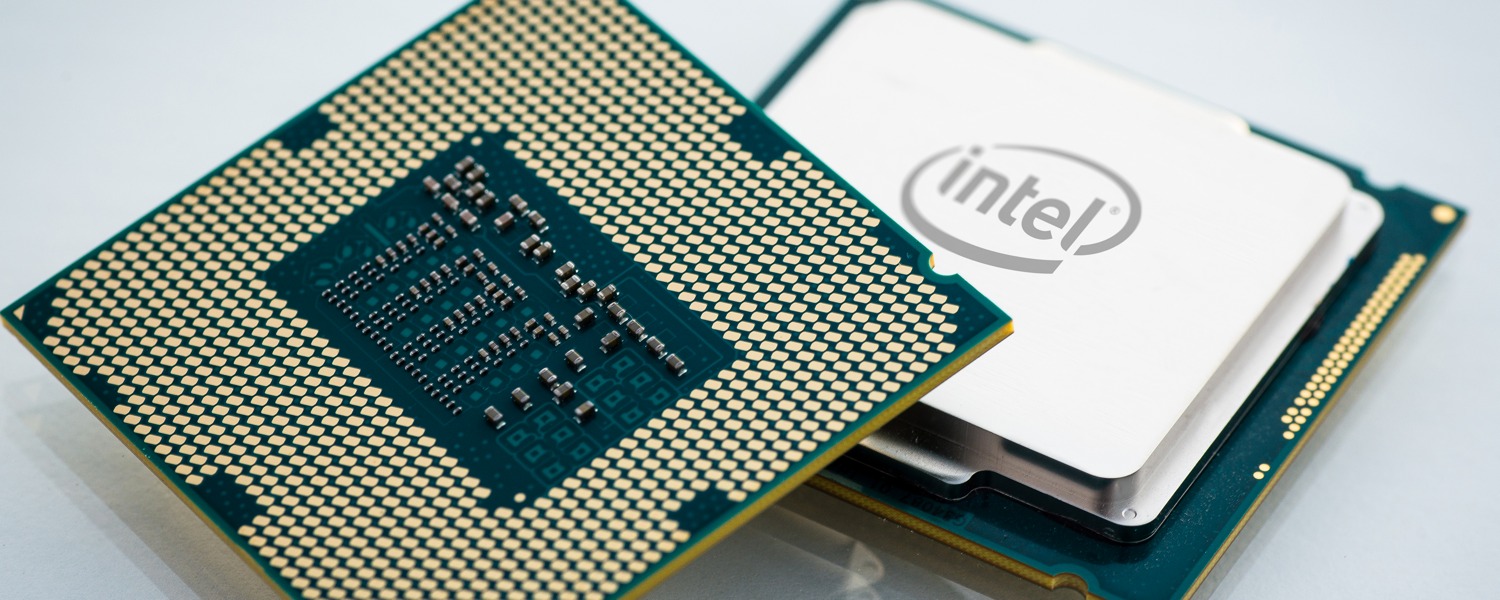If you are in the market for a new PC, you're probably all too aware of the huge variety of different CPU models available. In a previous article we covered the differences between the Haswell-based desktop Intel Core i3, i5, and i7 CPUs, but it turns out that there are actually two or three different product lines within each of those brands. You might may be familiar with the "K" or "X" lines, but did you know there are also "S", and "T" lines as well? According to Intel, these letter designators mean:
- K/X - "Unlocked" - the highest-end desktop CPU with overclocking support
- S - "Performance-optimized lifestyle," lower performance, lower power draw.
- T - "Power-optimized lifestyle," lowest performance, lowest power draw.
Matt Bach is the head of Puget Labs and has been part of Puget Systems, a boutique builder of gaming and workstation PCs, since the early days. This article was originally published on the Puget blog.
In this article, we want to cover the S-series product line in particular because the specifications for S-series processors are actually very similar to that of standard Intel CPUs. To determine the advantage of S-series CPUs we will first look at the official specifications differences between a couple of S-series processors and their standard counterparts then move on to our own testing and benchmarking to determine the actual performance, power draw, and thermal differences.
Specification Differences
To compare the official specifications between S-series CPUs and their standard counterparts we took four of the latest generation Haswell CPUs. There are, of course, more models available from Intel, but we've found that the differences between S-series and their standard counterparts to actually be very consistent, so this is a good representation of the S-series as a whole.
| Basic CPU Specifications | i7 4790 | i7 4790S | i5 4690 | i5 4690S |
| Base Freq. | 3.6 GHz | 3.2 GHz | 3.5 GHz | 3.2 GHz |
| Max Turbo Freq. | 4 GHz | 4 GHz | 3.9 GHz | 3.9 GHz |
| Cores/Threads | 4/8 | 4/8 | 4/4 | 4/4 |
| TDP (wattage) | 84 W | 65 W | 84 W | 65 W |
| Smart Cache | 8 MB | 8 MB | 6 MB | 6 MB |
| T case | 72.72 °C | 71.35 °C | 72.72 °C | 71.35 °C |
This isn't a complete list of all the official specifications (you can view a complete list at Intel's Ark page) but it covers most of the major specifications and all of the ways in which the CPUs officially differ. According to Intel's official specifications, there are really only three differences between the two different model types.
First, the S-series CPUs have a much lower base frequency than the standard CPUs. You would think this means that they will always be slower, but we've shown in the past that the base frequency is somewhat of a meaningless specification due to Intel's Turbo Boost and Speedstep technologies. These technologies mean that an Intel CPU will only rarely operate at the advertised base frequency which brings into question whether this spec actually has any bearing on real-world performance.
The second difference is the lower TDP wattage on the S-series processors. Again, this is a misleading specification since according to the Intel Ark specification pages, TDP is defined as ... the average power, in watts, the processor dissipates when operating at Base Frequency with all cores active under an Intel-defined, high-complexity workload.
In other words, TDP is only what the wattage of the CPU is when running at the base frequency, not the maximum frequency as determined by Turbo Boost. And since we have found that the base frequency isn't a great indicator of performance, this means that TDP is also a questionable specification. It certainly indicates that the S-series processors should run at a lower wattage, but unless you disable Turbo Boost it does not in any way guarantee it.
Finally, the last difference is the lower T case temperature on the S-series CPUs. This is related to Intel's overheating protection and basically is the thermal cutoff point where an Intel CPU will automatically lower its operating frequency to try to reduce the amount of heat the CPU is generating. More information on this is available in our Impact of Temperature on Intel CPU Performance article. Realistically, as long as a CPU has adequate cooling this specification should never have a bearing on the performance of the CPU.
To sum up, all the official specifications really tell us is that S-series processors may be a bit slower and may run a bit cooler than their standard equivalent but it is far from conclusive. For that, we will need to perform our own testing.
Test Setup
Since Intel's specifications are not very great at showing the actual difference between the S-series and standard CPUs, we decided to compare a Core i7 4790 and a Core i7 4790S to determine the actual power draw, thermal, and performance differences between the two CPUs. For this testing, we used the following hardware:
| Testing Hardware | |
| Motherboard: | Asus Z97-A |
| CPU: |
Intel Core i7 4790 3.6GHz 84W Quad Core Intel Core i7 4790S 3.2GHz 65W Quad Core |
| RAM: | 4x Kingston DDR3-1600 8GB |
| GPU: | NVIDIA GeForce GTX 980 4GB |
| Hard Drive: | Samsung 850 Pro 128GB SATA 6Gb/s SSD |
| OS: | Windows 8.1 Pro 64-bit |
| PSU: | Seasonic X-650 650W |
| CPU Cooler | Cooler Master Hyper TX3 |
All driver and Windows updates were applied prior to testing. Coretemp was used to record both the CPU temperature and operating frequency along with a "watts up? PRO" power meter with USB logging to record the system power draw.
Real world difference between 4790 and 4790S
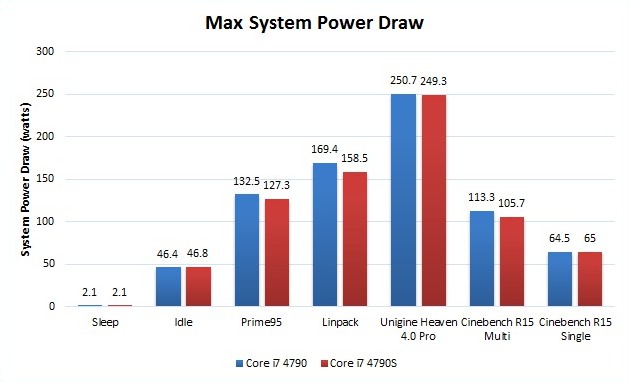
Starting with the overall system's power draw, we found that while the system was idle or in sleep mode, the two CPUs had almost identical power draw. While running our various benchmarks, however, we started to see a mix of results. In both Unigine Heaven 4.0 Pro and Cinebench R15 (single threaded mode) both CPUs had almost identical system power draw. Only Prime95, Linpack, and Cinebench R15 (multi threaded mode) resulted in the Core i7 4790S using less power. Even then, the difference was only 5-10 watts (or 4-7%) which is far less than the 19 watt difference that Intel advertises.
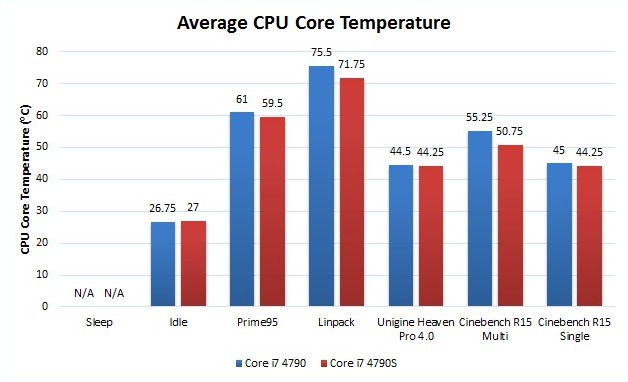
Higher wattage should directly correlate to higher temperatures so it is no surprise that this graph is very similar to the power draw graph. The Core i7 4790S runs at approximately the same temperature as the Core i7 4790 at idle, during Unigine Heaven, and during the single threaded portion of Cinebench R15. Really, the only significant difference in temperature occurred during Linpack and Cinebench R15 (multi threaded mode) where the 4790S ran 4.5 ºC and 3.75 ºC (or 5% and 8%) cooler respectively.
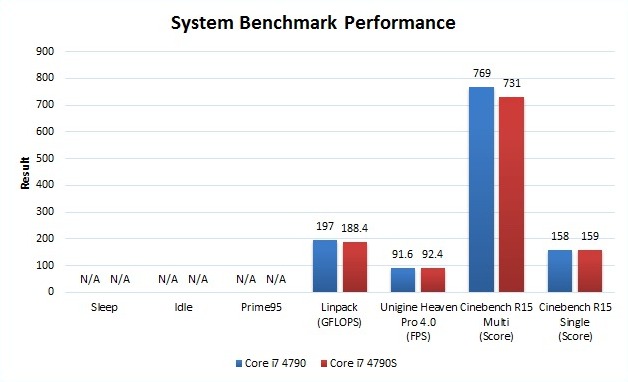
With the actual system performance results we start to see a very clear pattern. Just like the power draw and temperature results, Unigine Heaven and Cinebench R15 (single threaded mode) perform almost exactly the same with both CPUs. However, Linpack and Cinebench R15 (multi threaded mode) ran about 5% slower with the 4790S compared to the 4790.
So, why the big variance between the different benchmarks? Obviously, a pattern exists, since the 4790S and 4790 really only showed a difference in power draw, temperature, and performance during Prime95, Linpack, and Cinebench R15 (multi threaded mode). What we believe to be happening is in many ways related to the base frequency specification we discounted during the 'Specification Differences' section. It turns out even if a CPU never runs at its advertised base frequency, this specification is still an indicator of how effective Turbo Boost may be depending on the number of threads an application can use.
Performance based on number of active threads
As we pointed out earlier in this article, due to Intel's Turbo Boost technology an Intel CPU will almost always operate above its rated base frequency when put under load. What is often overlooked, however, is that the Turbo Boost frequency at which a CPU runs depends on the number of cores actively being used. In fact, the maximum Turbo Boost frequency Intel lists on their specification sheets only applies if the CPU is using just a single core. As increasingly more cores are used simultaneously, the maximum Turbo Boost frequency is reduced.
Likely, the inconsistencies we found in the previous section are related to how many threads each benchmark is able to utilize and how that affected the amount of Turbo Boost each CPU received. To determine the actual amount of Turbo Boost available to our test CPUs based on the number of active threads we ran Prime95 on each CPU with the bechmark limited to between one and eight active threads.
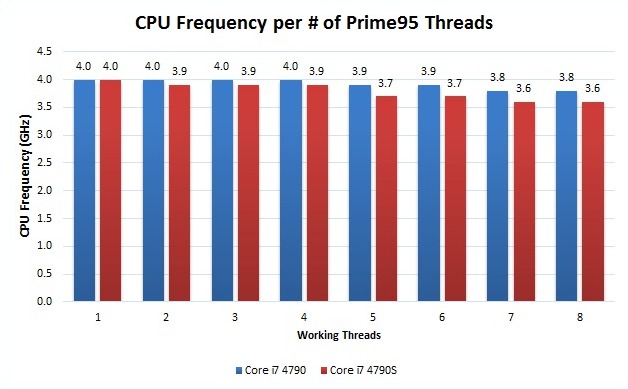
As you can see in the above chart, it is clear that as more CPU threads are being used, the 4790S runs at an increasingly lower frequency than the standard 4790. This means that even though the 4790S and 4790 technically have the exact same maximum Turbo Boost frequency, they are very different as more threads are being used. Depending on the number of threads, the 4790S is anywhere from .1 to .2 GHz slower than the 4790. This isn't much - only about 2.5 to 5.3% slower - but it lines up almost exactly with what we say in our real world benchmarks.
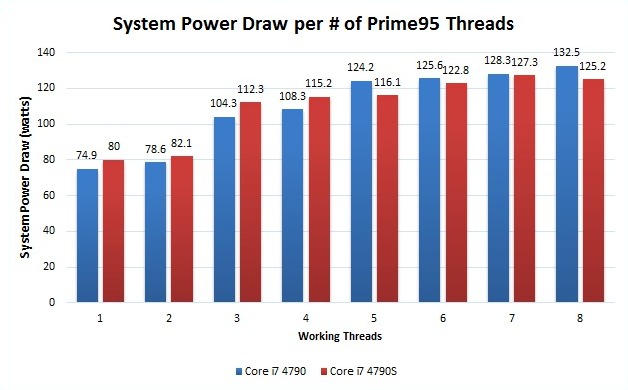
S-series processors are supposed to be lower wattage (that is how they are primarily advertised by Intel) so the slightly lower performance is to be expected and in some ways is secondary to the power draw of the S-series CPUs. What we found was that the 4790S did indeed draw less power when five to eight threads were being used, but with fewer than five threads the 4790S actually pulled more power than the standard 4790 by an average of 6%.
We have no explanation for why this is, although it could simply be that we had an unusually hot running 4790S and an unusually cool running 4790. Either way, our testing with these sample CPUs indicates that the 4790S is actually only lower power when more than half of the total CPU threads are under load.
Conclusion
To summarize both our research and testing results, there are three major ways in which Intel S-series processors differ from the standard models:
- Power Draw: Our testing between a Core i7 4790S and a Core i7 4790 indicates that S-series processors draw less power when more than half the threads on the CPU are being used. On the other hand, our testing also showed that the 4790S actually draw slightly more power when less than half threads are being used.
- Temperature: Even though the 4790S used more power in some applications than the 4790, we didn't really see the 4790S running any hotter than the 4790 in those instances. When the 4790S does use less power, however, we saw a drop in temperature of up to about 5 °C. This isn't insignificant, but at the same time is not going to be a game changer in most situations.
- Performance: On applications that can only utilize a few threads, the S-series CPUs are essentially identical in performance to their standard counterparts. If an application can use a higher number of CPU threads (or if many applications are running at once), however, the S-series CPUs can be as much as 5% slower than the standard models.
Overall, we would say that S-series CPUs can simply be thought of as being slightly slower, slightly cooler, and a little more power efficient than their standard counterparts. None of it is by very much - and in many situations the two models are really identical - but if you want a system that uses slightly less power in exchange for slightly lower performance than the S-series processors may be worth considering. One thing to keep in mind is that S-series CPUs are usually priced exactly the same as the standard CPUs so unless the small power savings is important you will get better performance for your dollar from the standard models.
